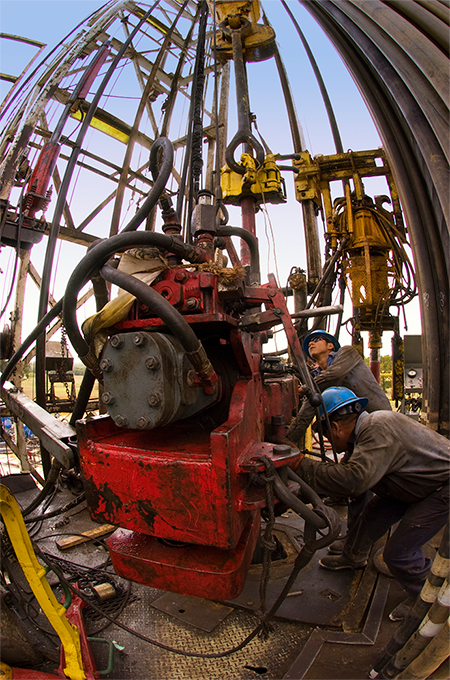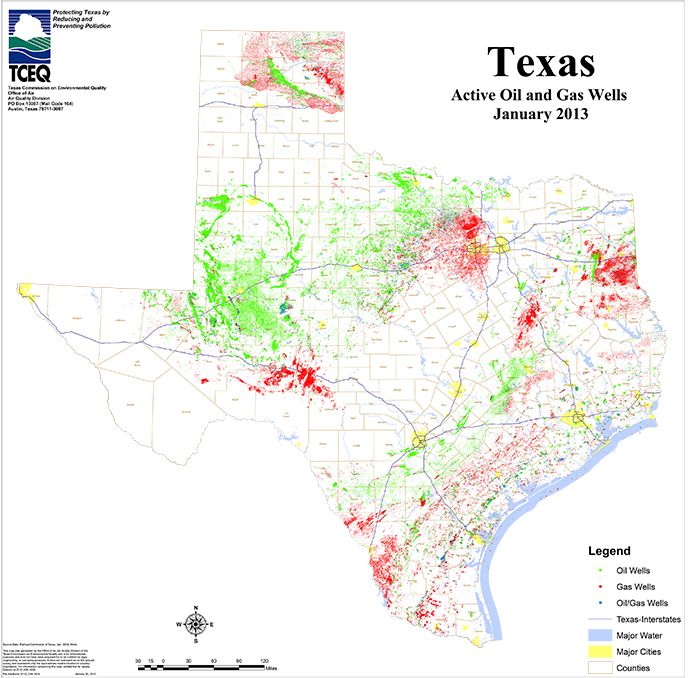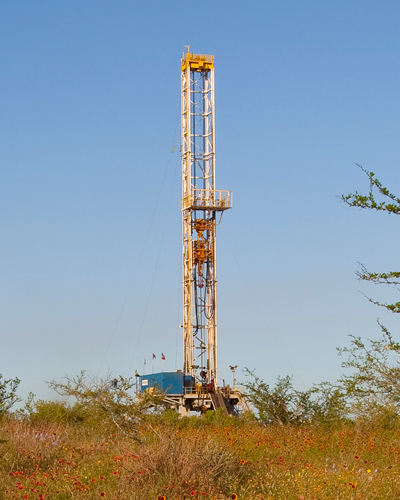
An Anadarko drilling rig in East Texas.
Photo courtesy of Anadarko
he summary below presents counterpoint to the recent reporting from InsideClimate News, the Center for Public Integrity and the Weather Channel, in the form of data and commentary from oil and gas industry regulators and companies in Texas. — Ed.
The primary target of a February series of articles documenting air quality complaints in the Eagle Ford Shale was the Texas Commission on Environmental Quality (TCEQ). In response to a query from Site Selection, the TCEQ sent a full document in response, which we present here in its entirety:
On February 18, 2014, Inside Climate News (ICN) and their partners, released a story entitled, “Texas officials turn blind eye to fracking industry’s toxic air emissions” that accuses the Texas agencies of not adequately regulating the oil and gas industry or their air emissions.
TConspicuously absent from the story is any scientific data supporting the claim that toxic air emissions are present in the Eagle Ford at harmful levels, much less any evidence that anyone is actually being harmed. With all the scientific monitoring (both canister and fixed monitor) done in the Eagle Ford to date, no emissions have been found that indicate there is any widespread concern for human health and the environment. The Texas Commission on Environmental Quality (TCEQ) has chosen to regulate based upon scientific facts and common sense. Even the biased ICN article acknowledges that the TCEQ went beyond what was federally required to mandate additional requirements on upstream oil and gas sources.
The TCEQ takes our task of protecting human health and the environment in a manner consistent with economic growth very seriously. Citizen complaints are responded to, and when investigations of nearby facilities find problems, the problems are fixed. Similar health complaints to those highlighted in the ICN article were recorded in the Barnett Shale when oil and gas production began to take place in the area. There were many complaints from residents of the town of DISH. Yet, when the Texas Department of State Health Services took blood and urine samples from nearly 30 volunteers from the town, scientific results showed that no community-wide exposure from oil and gas operations was occurring.
The TCEQ has conducted 3,869 investigations in relation to oil and gas operations since September 1, 2009 in the Barnett Shale and Eagle Ford Shale. The TCEQ has also conducted two aerial surveys in the Eagle Ford Shale area using infrared imaging cameras mounted on aircraft to identify potential sources of emissions in the summers of 2011 and 2013. In the most recent survey, in summer 2013, the flyover collected 286 aerial video images, and over 10,000 individual tanks were surveyed. The vast majority of these images identified no issues. Approximately 5 percent of the tanks were found to have some degree of emissions, either authorized or unauthorized. On-the-ground follow-up investigations are being conducted at facilities with observed emissions to determine compliance with authorizations and regulations. Additionally, the TCEQ, in coordination with other regulatory agencies, has conducted special outreach to make sure that oil and gas representatives are aware of the requirements, put additional resources into monitoring and investigations, often expedited investigations, and conducted research to better understand emissions associated with oil and gas activities.
Air quality planning in the Eagle Ford takes into account lessons learned in the Barnett Shale, where large-scale hydraulic fracturing operations began several years earlier, and in a much more populated environment. A network of 15 automated-gas chromatograph monitors take air samples measuring levels of more than 50 volatile organic compounds every hour, practically around the clock, and those results are posted on TCEQ’s public website. These long-term monitors have shown no levels of concern for any constituent. There has also been monitoring in response to complaints as well as general survey monitoring using state-of-the-art forward-looking infrared cameras at ground level as well [as] from helicopters to visualize hydrocarbon emissions. When issues are observed or measured, TCEQ investigators follow up and make sure that the emissions are addressed. Our experience shows that sites or equipment with higher emissions are due to equipment failure or human error (such as a hatch not being closed on a storage tank) rather than the need for additional rules or requirements.
The new automated gas chromatograph measuring volatile organic compounds on a near continuous basis in Floresville, installed to be downwind of the production field, is showing no cause for concern after beginning operations during the past summer. The data from this monitoring site will also be used to continue to evaluate ozone precursors generally upwind of the San Antonio area. Our experience and extensive monitoring in the Barnett Shale as well as available monitoring data downwind of the Eagle Ford Shale does not indicate a concern for human health.
The TCEQ plans to continue to monitor air quality, actively conduct investigations, and utilize technology to collect information and sound science to evaluate air quality and risks in and around areas of upstream oil and gas operations. If the data collected indicate the need for more fixed-site monitoring in the Eagle Ford Shale area, we will act accordingly based upon available scientific data. While improperly operated facilities can result in significant, temporary, local emissions, there are no indications at this time that these emissions are of sufficient concentration or duration to harm residents in and near the Eagle Ford or Barnett Shale. When issues with improperly operated facilities or equipment are identified, TCEQ strives to act swiftly and decisively to make sure that the equipment is fixed or operated properly to quickly minimize emissions.
Rather than printing opinions and inferring improprieties based on accusations and circumstantial information, it is important to focus on facts. The TCEQ has and continues to monitor and investigate these areas and these industries. There are regulations currently in effect with which these industries must comply. When the vast majority of facilities are in compliance and the equipment is operated properly, we have not measured levels of pollutants that should cause concern from a health perspective.
Unparalleled Boom
Originally created in the 1890s to regulate a railroad industry that needed it, the Railroad Commission of Texas (RRC) saw that role diminish to nothing by the 1980s. But it had done so well with rail that in 1919 it was also granted jurisdiction over oil and gas production.

This map from the Texas Commission on Environmental Quality illustrates the prevalence of oil and gas drilling across the entire state.
By 2001, the RRC monitored approximately 354,600 oil and gas wells. Today, the RRC monitors more than 410,000 wells across the state, an increase of 15.6 percent. More than 82.5 percent of Texas counties currently report oil production, and 73.6 percent of Texas counties produce natural gas.
In February testimony before the U.S. House Committee on Science, Space and Technology on what his organization calls “EPA overreach,” Texas Railroad Commissioner David Porter said, “If the EPA were to gain control of energy regulation, it would cripple the industry and devastate our economy. We in Texas know best how to achieve a balance of economic vitality and environmental safety, as we responsibly and proudly reign as the top producer in the country.”
“The surge in unconventional oil and gas drilling has considerably bolstered the national economy, attracting more than $120 billion in U.S.-based investments and contributing $284 billion to the gross domestic product in 2012,” he said. “By 2025, total contributions to the GDP are estimated to exceed $530 billion … Unconventional oil and gas activity supported 2.1 million jobs in 2012 and is also expected to bring in approximately $1.6 trillion in government revenues from 2012 through 2025.
Almost half of all drilling rigs in the country, and nearly
a quarter of the rigs in the world, are located in Texas.
In 2012, the energy boom in Texas added almost $75 billion in federal and state revenues, and lifted household income by more than $1,200, according to a report released in September 2013 by IHS CERA.
“Texas plays a huge role in American energy production, accounting for nearly 40 percent of U.S. crude oil and almost 30 percent of our country’s natural gas,” Porter continued. “In 2013, Texas’ statewide production increased for the sixth consecutive year, with estimated production reaching over 850 million barrels of oil, a 21.2-percent year-over-year increase. Almost half of all drilling rigs in the country, and nearly a quarter of the rigs in the world, are located in Texas. On average, each drilling rig operating in Texas results in $1.5 to $2 million of additional sales taxes paid on an annual basis.”
The commission’s drilling statistics show more holes drilled in 2013 (24,166) than in any year since the early 1980s, when the boom topped out at 30,898 holes drilled in 1984. Last year’s total number of drilling permits issued came to 21,471, after 22,479 in 2012 and 22,480 in 2011. According to the RRC, drilling permit processing time as of March 10, 2014, was 10 business days for expedited permits, and 20 business days for standard permits. Companies such as EOG and Devon Energy are planning massive spending in the region, with Devon planning to invest $1.1 billion this year alone, when it will drill more than 200 wells.
Vigilant Enough?
The sector has helped the state recover fast from the Great Recession, said Porter in his testimony. “Last year, oil and gas industry employment increased 6.4 percent compared to 2012, employing just under 300,000 workers,” he told the congressmen. “In 2013, state severance tax collections — which is based on the value of oil and gas production — set an all-time high at just under $4.5 billion, accounting for almost 10 percent of all state tax collections.”
As part of his testimony, he also summarized the RRC oil and gas division’s 125,000 field inspections. In addition, he said, in FY 2013, the Commission:
- Issued 21,471 drilling permits.
- Oversaw 24,922 oil and gas well completions.
- Processed more than 3,400 stationary installation completion reports and approvals, issued 5,279 licenses, and registered 4,778 transports and special delivery vehicles through LP-GasOperations.
- Completed 280 clean-up activities, including eight major clean-ups, through Site Remediation.
- Plugged 778 orphaned wells, including 30 orphaned bay wells in the state’s coastal waters.
- Implemented and released a new online application for the submittal of Gas and Oil Well Status Reports (forms G-10 and W-10). This system will process approximately 250,000 annual well tests filed by operators with daily updates ensuring accuracy, accelerated processing, and elimination of issues associated with paper filings.
Porter also claimed the RRC’s enforcement tools — primarily notices of violation and severance or seal orders — remain stout. Among the facts that went unreported in the InsideClimate News stories was that RRC revenue from severance/seal orders in 2013, at more than $3 million, was the highest in a decade, and that was with a huge number (3,609) of unresolved notices.
“Over the last 10 years, 94.4 percent of violations managed through this process have been resolved,” said Porter in his U.S. House testimony. “During this period, 62.2 percent of violations were corrected by the operator promptly upon first notice with no further action needed by the Commission, and another 32.1 percent were resolved following issuance of a severance/seal order.” He also said there has never been a confirmed case of groundwater contamination due to hydraulic fracturing in Texas.
As he made his case for the Texas approach, Porter took a swipe at the not-so-vigilant trend at the EPA, which has announced it’s reducing evaluations from 20,000 in 2012 to 14,000 per year between 2014 and 2018. “The agency also plans to initiate just over 2,000 civil judicial and administrative enforcement cases against violators, compared to 3,900 in 2009 and 3,000 in 2012,” said Porter. “In terms of responsible regulation and oversight, the pinnacle of one of the largest oil booms in our country’s history is an interesting time to cut down significantly on inspections and enforcement. In Texas, the Railroad Commission has increased inspections and enforcement to parallel an increase in activity.”
“The Railroad Commission has effectively regulated the oil and gas industry for nearly 100 years,” says RRC spokesperson Ramona Nye, “and is renowned around the world for our agency’s effective, predictable and transparent regulations that have provided stewardship of our state’s natural resources and the environment; personal and community safety; and also supported enhanced development and economic vitality for the benefit of all Texans.”
The Producers
According to the Texas Oil & Gas Association, in fiscal year 2012, Texas producers paid $3.6 billion in severance taxes on the production of oil and gas. Consequently, a $1.9 billion transfer was made to the State’s Economic Stabilization Fund, or “Rainy Day Fund,” at the beginning of fiscal 2013. As a result, the balance in the Fund now stands at over $8 billion, and is projected to reach $11.8 billion by the end of the next fiscal biennium.
The Rainy Day Fund has been spent by the Texas Legislature on an as-needed basis since the Fund began receiving deposits in 1990. “All types of state programs have benefited,” says the association, “ranging from Texas’ public schools to children’s health insurance to economic development. It could be tapped again in the future by the Legislature, to finance state infrastructure or other needs. In using the Rainy Day Fund, pressure to increase taxes or cut programs during hard times has been relieved — courtesy of Texas’ oil and gas taxpayers.”
Below are jobs and tax/royalty statistics related to the oil and gas boom engendered by fracking in Texas.
JOBS
| CRUDE PETROLEUM & NATURAL GAS EXTRACTION |
JOBS | WAGES | AVERAGE PER JOB |
|---|---|---|---|
| Crude Petroleum & Natural Gas Extraction | 89,548 | $15,851,778,975 | $177,020 |
| Natural Gas Liquid Extraction | 2,990 | $441,736,403 | $147,726 |
| Drilling Oil and Gas Wells | 42,989 | $4,342,342,027 | $101,010 |
| Support Activities, Oil/Gas Operations | 108,974 | $9,570,284,058 | $87,822 |
| Natural Gas Distribution | 7,740 | $925,390,709 | $119,567 |
| Petroleum Refineries | 21,377 | $2,812,941,159 | $131,589 |
| Petrochemical Manufacturing | 15,423 | $1,721,636,887 | $111,632 |
| Oil and Gas Field Machinery & Equipment | 49,751 | $4,615,721,817 | $92,777 |
| Petroleum Merchant Wholesalers | 14,638 | $1,441,261,070 | $98,462 |
| Pipeline Transportation | 16,081 | $2,325,978,346 | $144,644 |
| Total Oil & Gas Industry | 369,510 | $44,049,071,451 | $119,210 |
| Total Oil & Gas Industry | 8,427,019 | $403,127,111,674 | $47,837 |
SOURCE: Texas Workforce Commission, Quarterly Employment and Wages (QCEW) data series.
TAXES & ROYALTIES PAID, FISCAL 2012
| AMOUNT IN MILLIONS | AMOUNT PER JOB *** | ||
|---|---|---|---|
| OIL AND GAS | OIL AND GAS | ALL OTHER INDUSTRIES | |
| Property * | $3,654 | $9,889 | $2,426 |
| Sales, state and local * | $2,521 | $6,824 | $1,423 |
| State franchise tax * | $476 | $1,287 | $451 |
| Production of oil ** | $2,103 | $5,692 | – |
| Production of natural gas ** | $1,535 | $4,153 | – |
| Oil and gas well servicing ** | $122 | $331 | – |
| Other taxes * | $311 | $841 | $629 |
| Total Taxes * | $10,722 | $29,018 | $4,930 |
| Royalties to State Funds** | $1,348 | $3,648 | $6 |
| Total Paid | $12,070 | $32,665 | $4,936 |
* Estimated, Tax & Fiscal Consulting, Austin
** Source: Texas Comptroller’s Office
*** Employment data provided by Texas Workforce Commission

An Anadarko drilling rig in the Eagle Ford Shale in Southwest Texas. Anadarko is among the largest producers in the Eagleford Shale with approximately 388,000 gross acres in Dimmit, LaSalle, Maverick and Webb Counties, and more than 2,500 drill sites. In the fourth quarter of 2013, the company achieved net sales volumes of 53,000 BOE per day from the formation, an increase of 36 percent over the fourth quarter of 2012.
Photo courtesy of Anadarko
In December, Texas was one of 12 states whose governors threw their support behind the States First Initiative (www.statesfirstinitiative.org) — an effort aimed at supporting and enhancing the role of the states as the primary and appropriate regulators of oil and gas development.
“Our programs, which are as varied as the geography, climate, geology and social fabric of our states, are designed to be flexible, yet effective, in providing the world’s best environmental protection and regulation,” the letter stated. “The states’ ability to design effective regulations that reflect state-specific needs is a vital element in the resurgence of our nation’s oil and natural gas industry.”
States First is a partnership between the Interstate Oil & Gas Compact Commission and the Ground Water Protection Council, two state-led organizations representing governors and state regulators. Supporting states produce the majority of the oil and natural gas in the United States and include Gov. Phil Bryant of Mississippi, Gov. Robert Bentley of Alabama, Gov. Steven L. Beshear of Kentucky, Gov. Steve Bullock of Montana, Gov. Tom Corbett of Pennsylvania, Gov. Jack Dalrymple of North Dakota, Gov. Mary Fallin of Oklahoma, Gov. Gary Herbert of Utah, Gov. John Hickenlooper of Colorado, Gov. Sean Parnell of Alaska, Gov. Rick Perry of Texas and Gov. Brian Sandoval of Nevada.